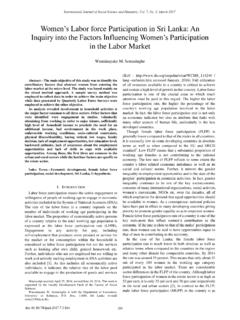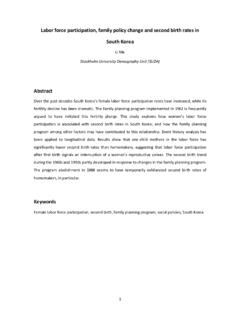Transcription of 75 90 Female Participation Rate in OECD Regions 60
1 Female Participation Rate in OECD Regions OECD Regions at a Glance 2013 The interactive edition December 2013 Definitions The Participation rate is the ratio of the labour force to the working age population. The labour force is defined as the sum of employed and unemployed people. Employed persons are all persons who, during the reference week, worked at least one hour for pay or profit or were temporarily absent from such work. Family workers are included. The Female employment rate is calculated as the ratio between Female employment and Female working-age population (aged 15-64 years). Differences in the Female Participation rate can, to some extent, be attributed to culture and social norms; yet, they also reflect economic incentives.
2 Looking at the issue through the lens of demographic change, inceasing the Female Participation rate should be widely supported, as in an ageing society the downward pressure on labour supply could be mitigated through policies targeting to increase the share of Female labour force Participation . In 2011, 69% of women in OECD countries were in the labour force , compared to 88% of men. Within the countries of the OECD wide regional differences in the Female Participation rate exist. Female Participation in the workforce was more than 25 percentage points lower than male Participation in many Regions in Chile, Italy, Mexico and Turkey. In Chile and Mexico these differences are due to particularly low Female labour - force Participation in predominantly rural areas; while in Italy and Turkey the difference between male and Female Participation rates is often marked in predominantly urban Regions and in medium-sized urban areas.
3 Countries ranked by size of difference in TL2 regional Female Participation rates , 2011 Source: OECD Regions at a Glance 2013 Broadening access to women in the labour market would require a mix of policies, including measures to reconcile family and work life. Regional differences in Female Participation rates suggest that the availability and use of services to reconcile family and work life are also quite diverse within countries. The Female employment rate has increased in OECD countries over the past decades, reaching 57% in 2011. However, in around 26% of OECD Regions , less than one out of two women was employed in 2011. Regional disadvantages in Female employmentwere the largest inTurkey, Italy, Spain, Israel, the United States and the Slovak.
4 Countries ranked by size of difference in TL2 regional Female employment rates , 2011 Source: OECD Regions at a Glance 2013 0 15 30 45 60 75 90 SloveniaGreeceNetherlandsIrelandAustriaD enmarkSwedenCzech RepublicUnited KingdomNorwayAustraliaBelgiumSwitzerland HungaryIcelandCanadaFinlandJapanGermanyN ew ZealandSlovak RepublicKoreaPortugalChileSpainMexicoUni ted StatesFrancePolandIsraelItalyTurkey%mini mum value country average maximum value0153045607590 SloveniaNetherlandsIrelandGreeceDenmarkN orwayIcelandAustriaSwedenAustraliaUnited KingdomSwitzerlandCzech RepublicHungaryGermanyCanadaBelgiumJapan FinlandNew ZealandPortugalKoreaChileMexicoFrancePol andSlovak RepublicUnited StatesIsraelSpainItalyTurkey%minimum countryaveragefemale employment rate maximum Links.
5 OECD Regions at a Glance 2013 OECD Regional Statistics and Indicators Regions at a Glance interactive









